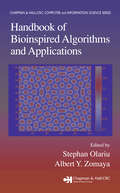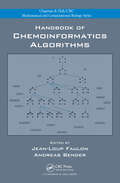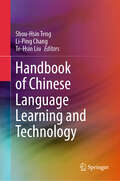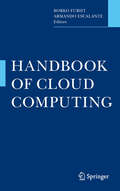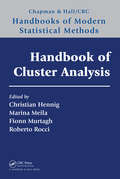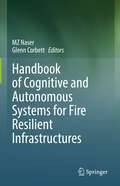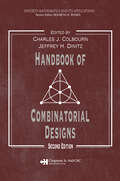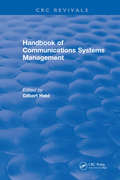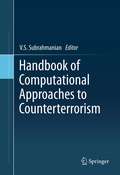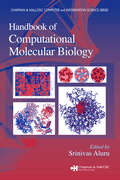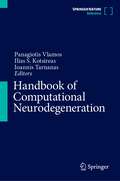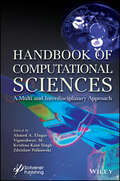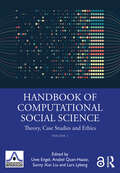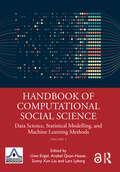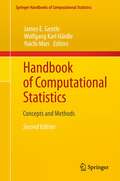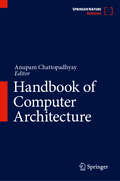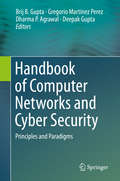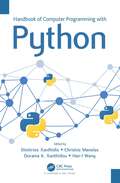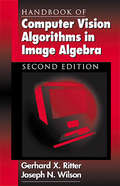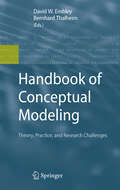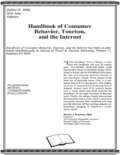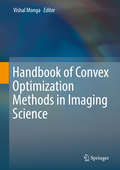- Table View
- List View
Handbook of Biochips: Integrated Circuits and Systems for Biology and Medicine
by Mohamad SawanThis book provides a broad survey of the field of biochips, including fundamentals of microelectronics and biomaterials interaction with various, living tissues, as well as numerous, diverse applications. Although a wide variety of biochips will be described, there will be a focus on those at the brain-machine interface. Analysis is included of the relationship between different categories of biochips and their interactions with the body and coverage includes wireless remote control of biochips and arrays of microelectrodes, based on new biomaterials.
Handbook of Bioinspired Algorithms and Applications
by Albert Y. Zomaya Stephan OlariuThe mystique of biologically inspired (or bioinspired) paradigms is their ability to describe and solve complex relationships from intrinsically very simple initial conditions and with little or no knowledge of the search space. Edited by two prominent, well-respected researchers, the Handbook of Bioinspired Algorithms and Applications reveals the
Handbook of Biometric Anti-Spoofing: Presentation Attack Detection and Vulnerability Assessment (Advances in Computer Vision and Pattern Recognition)
by Nicholas Evans Sébastien Marcel Julian FierrezThe third edition of this authoritative and comprehensive handbook is the definitive work on the current state of the art of Biometric Presentation Attack Detection (PAD) – also known as Biometric Anti-Spoofing. Building on the success of the previous editions, this thoroughly updated third edition has been considerably revised to provide even greater coverage of PAD methods, spanning biometrics systems based on face, fingerprint, iris, voice, vein, and signature recognition. New material is also included on major PAD competitions, important databases for research, and on the impact of recent international legislation. Valuable insights are supplied by a selection of leading experts in the field, complete with results from reproducible research, supported by source code and further information available at an associated website.Topics and features: reviews the latest developments in PAD for fingerprint biometrics, covering recent technologies like Vision Transformers, and review of competition series; examines methods for PAD in iris recognition systems, the use of pupil size measurement or multiple spectra for this purpose; discusses advancements in PAD methods for face recognition-based biometrics, such as recent progress on detection of 3D facial masks and the use of multiple spectra with Deep Neural Networks; presents an analysis of PAD for automatic speaker recognition (ASV), including a study of the generalization to unseen attacks; describes the results yielded by key competitions on fingerprint liveness detection, iris liveness detection, and face anti-spoofing; provides analyses of PAD in finger-vein recognition, in signature biometrics, and in mobile biometrics; includes coverage of international standards in PAD and legal aspects of image manipulations like morphing.This text/reference is essential reading for anyone involved in biometric identity verification, be they students, researchers, practitioners, engineers, or technology consultants. Those new to the field will also benefit from a number of introductory chapters, outlining the basics for the most important biometrics.This text/reference is essential reading for anyone involved in biometric identity verification, be they students, researchers, practitioners, engineers, or technology consultants. Those new to the field will also benefit from a number of introductory chapters, outlining the basics for the most important biometrics.
Handbook of Cell Biosensors
by Sylvia Daunert Shimshon Belkin Sylvain Martel Paul Freemont Julie Hermans Isao Karube Elisa Michelini Aldo RodaThis handbook is an interdisciplinary and comprehensive reference covering all aspects of cell biosensors. It is divided into four main sections which are led and organized by numerous international experts. The scope of coverage includes: Fundamentals and genetics for biosensor applicationsTransducers, Materials and SystemsMarkets, innovation and educationApplication of biosensors in business Biosensor research is an exciting hybrid world where biologists, chemists, physicists, engineers and computer engineers come together. This handbook will serve as an invaluable living resource for all researchers in academia and industry working with cell biosensors.
Handbook of Chemoinformatics Algorithms (Chapman & Hall/CRC Computational Biology Series)
by Jean-Loup Faulon Andreas BenderUnlike in the related area of bioinformatics, few books currently exist that document the techniques, tools, and algorithms of chemoinformatics. Bringing together worldwide experts in the field, the Handbook of Chemoinformatics Algorithms provides an overview of the most common chemoinformatics algorithms in a single source.After a historical persp
Handbook of Chinese Language Learning and Technology
by Shou-Hsin Teng Li-Ping Chang Te-Hsin LiuThis handbook explores quantitative linguistics, pedagogy, and Mandarin language acquisition in an integrated fashion and helps readers grasp how insights from quantitative linguistics can shed light on Mandarin language acquisition. It focuses on issues related to language processing, learning, and teaching and how these aspects are affected or enhanced by corpus-based and computational linguistics. By following a data-driven approach, the handbook demonstrates how theoretical problems in the acquisition of Chinese can be resolved with empirical evidence. The book serves as an essential resource for students and researchers wishing to explore the fascinating field of Chinese language processing and acquisition.
Handbook of Cloud Computing
by Borko Furht Armando EscalanteCloud computing has become a significant technology trend. Experts believe cloud computing is currently reshaping information technology and the IT marketplace. The advantages of using cloud computing include cost savings, speed to market, access to greater computing resources, high availability, and scalability. Handbook of Cloud Computing includes contributions from world experts in the field of cloud computing from academia, research laboratories and private industry. This book presents the systems, tools, and services of the leading providers of cloud computing; including Google, Yahoo, Amazon, IBM, and Microsoft. The basic concepts of cloud computing and cloud computing applications are also introduced. Current and future technologies applied in cloud computing are also discussed. Case studies, examples, and exercises are provided throughout. Handbook of Cloud Computing is intended for advanced-level students and researchers in computer science and electrical engineering as a reference book. This handbook is also beneficial to computer and system infrastructure designers, developers, business managers, entrepreneurs and investors within the cloud computing related industry.
Handbook of Cluster Analysis (Chapman & Hall/CRC Handbooks of Modern Statistical Methods)
by Fionn Murtagh Marina Meila Roberto Rocci Christian HennigHandbook of Cluster Analysis provides a comprehensive and unified account of the main research developments in cluster analysis. Written by active, distinguished researchers in this area, the book helps readers make informed choices of the most suitable clustering approach for their problem and make better use of existing cluster analysis tools.The
Handbook of Cognitive and Autonomous Systems for Fire Resilient Infrastructures
by Glenn Corbett Mz NaserThis handbook aims at modernizing the current state of civil engineering and firefighting, especially in this era where infrastructures are reaching new heights, serving diverse populations, and being challenged by unique threats. Its aim is to set the stage toward realizing contemporary, smart, and resilient infrastructure.The Handbook of Cognitive and Autonomous Systems for Fire Resilient Infrastructures draws convergence between civil engineering and firefighting to the modern realm of interdisciplinary sciences (i.e., artificial intelligence, IoT, robotics, sensing, and human psychology). As such, this work aims to revolutionize the current philosophy of design for one of the most notorious extreme events: fire. Unlike other publications, which are narrowed to one specific research area, this handbook cultivates a paradigm in which critical aspects of structural design, technology, and human behavior are studied and examined through chapters written by leaders in their fields. This handbook can also serve as a textbook for graduate and senior undergraduate students in Civil, Mechanical, and Fire Protection engineering programs as well as for students in Architectural and social science disciplines. Students, engineers, academics, professionals, scientists, firefighters, and government officials involved in national and international societies such as the American Society of Civil Engineers (ASCE), Society of Fire Protection Engineers (SFPE), National Fire Protection Association (NFPA), and Institute of Electrical and Electronics Engineers (IEEE), among others, will benefit from this handbook.
Handbook of Combinatorial Designs (Discrete Mathematics and Its Applications)
by Charles J. Colbourn Jeffrey H. DinitzContinuing in the bestselling, informative tradition of the first edition, the Handbook of Combinatorial Designs, Second Edition remains the only resource to contain all of the most important results and tables in the field of combinatorial design. This handbook covers the constructions, properties, and applications of designs as well as existence
Handbook of Communications Systems Management: 1999 Edition
by Gilbert HeldAs a manager of the �90s, you know that IT departments like your own must continue to meet increasingly sophisticated end-user needs despite highly limited resources. Learn when it�s best to farm out work to consultants, when to reserve internal resources for other tasks, and how best to use your in-house staff. Coverage unlike any other in the marketplace. Written by 41 experts � all practitioners in the networking and IS management fields � this guidebook provides unique depth and scope. In this Third Edition, you�ll find all new material that clearly outlines today�s hottest issues. Prepares you to quickly respond to management requirements. Are you aware of the latest on strategic planning, systems planning, and points-of-failure planning? Have you linked your IT architecture and business plans? Have you updated senior management as to how IT can help achieve corporate goals? Do you have a corporate technology plan? Turn to the Handbook for all this and more. Now you can get up to speed on the latest in client/server, on how to give your end users faster and greater access to corporate data at a lower cost, and on how to quantify the amount of network support that this improvement will require? The Handbook was written with you in mind. The perfect resource for today�s successful communications systems manager. This comprehensive, highly authoritative reference is designed to help you select, maintain, and manage your communications systems. It provides all the tools you need to evaluate, formulate, and implement effective communications network strategies to keep pace with today�s rapidly changing technology. You get illustrations, tables, and diagrams to clearly outline and guide you the entire way. Be aware of the latest technologies and their impact on you. Keep costs down by aiding your thinking through all the systems and network elements from concept through implementation and day-to-day operation.
Handbook of Computational Approaches to Counterterrorism
by V. S. SubrahmanianTerrorist groups throughout the world have been studied primarily through the use of social science methods. However, major advances in IT during the past decade have led to significant new ways of studying terrorist groups, making forecasts, learning models of their behaviour, and shaping policies about their behaviour. Handbook of Computational Approaches to Counterterrorism provides the first in-depth look at how advanced mathematics and modern computing technology is shaping the study of terrorist groups. This book includes contributions from world experts in the field, and presents extensive information on terrorism data sets, new ways of building such data sets in real-time using text analytics, introduces the mathematics and computational approaches to understand terror group behaviour, analyzes terror networks, forecasts terror group behaviour, and shapes policies against terrorist groups. Auxiliary information will be posted on the book's website. This book targets defence analysts, counter terror analysts, computer scientists, mathematicians, political scientists, psychologists, and researchers from the wide variety of fields engaged in counter-terrorism research. Advanced-level students in computer science, mathematics and social sciences will also find this book useful.
Handbook of Computational Molecular Biology (Chapman & Hall/CRC Computer and Information Science Series)
by Srinivas AluruThe enormous complexity of biological systems at the molecular level must be answered with powerful computational methods. Computational biology is a young field, but has seen rapid growth and advancement over the past few decades. Surveying the progress made in this multidisciplinary field, the Handbook of Computational Molecular Biology of
Handbook of Computational Neurodegeneration
by Ilias S. Kotsireas Panagiotis Vlamos Ioannis TarnanasThe Handbook of Computational Neurodegeneration provides a comprehensive overview of the field and thus bridges the gap between standard textbooks of research on neurodegeneration and dispersed publications for specialists that have a narrowed focus on computational methods to study this complicated process. The handbook reviews the central issues and methodological approaches related to the field for which the reader pursues a thorough overview. It also conveys more advanced knowledge, thus serving both as an introductory text and as a starting point for an in-depth study of a specific area, as well as a quick reference source for the expert by reflecting the state of the art and future prospects. The book includes topics that are usually missing in standard textbooks and that are only marginally represented in the specific literature. The broad scope of this handbook is reflected by five major parts that facilitate an integration of computational concepts, methods and applications in the study of neurodegeneration. Each part is intended to stand on its own, giving an overview of the topic and the most important problems and approaches, which are supported by examples, practical applications, and proposed methodologies. The basic concepts and knowledge, standard procedures and methods are presented, as well as recent advances and new perspectives.
Handbook of Computational Sciences: A Multi and Interdisciplinary Approach
by Krishna Kant Singh Zdzislaw Polkowski Ahmed A. Elgnar Vigneshwar MThe Handbook of Computational Sciences is a comprehensive collection of research chapters that brings together the latest advances and trends in computational sciences and addresses the interdisciplinary nature of computational sciences, which require expertise from multiple disciplines to solve complex problems. This edited volume covers a broad range of topics, including computational physics, chemistry, biology, engineering, finance, and social sciences. Each chapter provides an in-depth discussion of the state-of-the-art techniques and methodologies used in the respective field. The book also highlights the challenges and opportunities for future research in these areas. The volume pertains to applications in the areas of imaging, medical imaging, wireless and WS networks, IoT with applied areas, big data for various applicable solutions, etc. This text delves deeply into the core subject and then broadens to encompass the interlinking, interdisciplinary, and cross-disciplinary sections of other relevant areas. Those areas include applied, simulation, modeling, real-time, research applications, and more. Audience Because of the book’s multidisciplinary approach, it will be of value to many researchers and engineers in different fields including computational biologists, computational chemists, and physicists, as well as those in life sciences, neuroscience, mathematics, and software engineering.
Handbook of Computational Social Science, Volume 1: Theory, Case Studies and Ethics (European Association of Methodology Series)
by Lars Lyberg Uwe Engel Anabel Quan-Haase Sunny Xun LiuThe Handbook of Computational Social Science is a comprehensive reference source for scholars across multiple disciplines. It outlines key debates in the field, showcasing novel statistical modeling and machine learning methods, and draws from specific case studies to demonstrate the opportunities and challenges in CSS approaches. The Handbook is divided into two volumes written by outstanding, internationally renowned scholars in the field. This first volume focuses on the scope of computational social science, ethics, and case studies. It covers a range of key issues, including open science, formal modeling, and the social and behavioral sciences. This volume explores major debates, introduces digital trace data, reviews the changing survey landscape, and presents novel examples of computational social science research on sensing social interaction, social robots, bots, sentiment, manipulation, and extremism in social media. The volume not only makes major contributions to the consolidation of this growing research field but also encourages growth in new directions. With its broad coverage of perspectives (theoretical, methodological, computational), international scope, and interdisciplinary approach, this important resource is integral reading for advanced undergraduates, postgraduates, and researchers engaging with computational methods across the social sciences, as well as those within the scientifi c and engineering sectors.
Handbook of Computational Social Science, Volume 2: Data Science, Statistical Modelling, and Machine Learning Methods (European Association of Methodology Series)
by Lars Lyberg Uwe Engel Anabel Quan-Haase Sunny Xun LiuThe Handbook of Computational Social Science is a comprehensive reference source for scholars across multiple disciplines. It outlines key debates in the field, showcasing novel statistical modeling and machine learning methods, and draws from specific case studies to demonstrate the opportunities and challenges in CSS approaches. The Handbook is divided into two volumes written by outstanding, internationally renowned scholars in the field. This second volume focuses on foundations and advances in data science, statistical modeling, and machine learning. It covers a range of key issues, including the management of big data in terms of record linkage, streaming, and missing data. Machine learning, agent-based and statistical modeling, as well as data quality in relation to digital trace and textual data, as well as probability, non-probability, and crowdsourced samples represent further foci. The volume not only makes major contributions to the consolidation of this growing research field, but also encourages growth into new directions. With its broad coverage of perspectives (theoretical, methodological, computational), international scope, and interdisciplinary approach, this important resource is integral reading for advanced undergraduates, postgraduates, and researchers engaging with computational methods across the social sciences, as well as those within the scientific and engineering sectors.
Handbook of Computational Statistics
by Wolfgang Karl Härdle James E. Gentle Yuichi MoriThe Handbook of Computational Statistics - Concepts and Methods (second edition) is a revision of the first edition published in 2004, and contains additional comments and updated information on the existing chapters, as well as three new chapters addressing recent work in the field of computational statistics. This new edition is divided into 4 parts in the same way as the first edition. It begins with "How Computational Statistics became the backbone of modern data science" (Ch.1): an overview of the field of Computational Statistics, how it emerged as a separate discipline, and how its own development mirrored that of hardware and software, including a discussion of current active research. The second part (Chs. 2 - 15) presents several topics in the supporting field of statistical computing. Emphasis is placed on the need for fast and accurate numerical algorithms, and some of the basic methodologies for transformation, database handling, high-dimensional data and graphics treatment are discussed. The third part (Chs. 16 - 33) focuses on statistical methodology. Special attention is given to smoothing, iterative procedures, simulation and visualization of multivariate data. Lastly, a set of selected applications (Chs. 34 - 38) like Bioinformatics, Medical Imaging, Finance, Econometrics and Network Intrusion Detection highlight the usefulness of computational statistics in real-world applications.
Handbook of Computer Architecture
by Anupam ChattopadhyayThis handbook presents the key topics in the area of computer architecture covering from the basic to the most advanced topics, including software and hardware design methodologies. It will provide readers with the most comprehensive updated reference information covering applications in single core processors, multicore processors, application-specific processors, reconfigurable architectures, emerging computing architectures, processor design and programming flows, test and verification. This information benefits the readers as a full and quick technical reference with a high-level review of computer architecture technology, detailed technical descriptions and the latest practical applications.
Handbook of Computer Networks and Cyber Security: Principles and Paradigms
by Gregorio Martinez Perez Deepak Gupta Brij B. Gupta Dharma P. AgrawalThis handbook introduces the basic principles and fundamentals of cyber security towards establishing an understanding of how to protect computers from hackers and adversaries. The highly informative subject matter of this handbook, includes various concepts, models, and terminologies along with examples and illustrations to demonstrate substantial technical details of the field. It motivates the readers to exercise better protection and defense mechanisms to deal with attackers and mitigate the situation. This handbook also outlines some of the exciting areas of future research where the existing approaches can be implemented.Exponential increase in the use of computers as a means of storing and retrieving security-intensive information, requires placement of adequate security measures to safeguard the entire computing and communication scenario. With the advent of Internet and its underlying technologies, information security aspects are becoming a prime concern towards protecting the networks and the cyber ecosystem from variety of threats, which is illustrated in this handbook.This handbook primarily targets professionals in security, privacy and trust to use and improve the reliability of businesses in a distributed manner, as well as computer scientists and software developers, who are seeking to carry out research and develop software in information and cyber security. Researchers and advanced-level students in computer science will also benefit from this reference.
Handbook of Computer Programming with Python
by Dimitrios XanthidisThis handbook provides a hands-on experience based on the underlying topics, and assists students and faculty members in developing their algorithmic thought process and programs for given computational problems. It can also be used by professionals who possess the necessary theoretical and computational thinking background but are presently making their transition to Python. Key Features: • Discusses concepts such as basic programming principles, OOP principles, database programming, GUI programming, application development, data analytics and visualization, statistical analysis, virtual reality, data structures and algorithms, machine learning, and deep learning. • Provides the code and the output for all the concepts discussed. • Includes a case study at the end of each chapter. This handbook will benefit students of computer science, information systems, and information technology, or anyone who is involved in computer programming (entry-to-intermediate level), data analytics, HCI-GUI, and related disciplines.
Handbook of Computer Vision Algorithms in Image Algebra
by Joseph N. Wilson Gerhard X. RitterImage algebra is a comprehensive, unifying theory of image transformations, image analysis, and image understanding. In 1996, the bestselling first edition of the Handbook of Computer Vision Algorithms in Image Algebra introduced engineers, scientists, and students to this powerful tool, its basic concepts, and its use in the concise representation
Handbook of Conceptual Modeling
by Bernhard Thalheim David W. EmbleyThe Handbook of Conceptual Modeling collects many of the best conceptual-modeling ideas, techniques, and practices as well as the challenges that drive research in the field. It points toward interesting challenges.
Handbook of Consumer Behavior, Tourism, and the Internet
by Juline Mills Rob LawMake the most of your online business resources The growing acceptance and use of the Internet as an increasingly valuable travel tool has tourism and hospitality businesses taking a critical look at their business-to-customer online environments while pondering such questions as, "How do I get people to visit my Web site?" "Is my Web site attracting the &’right&’ kind of e-consumers?" and "How do I turn browsers into buyers?" The Handbook of Consumer Behavior, Tourism, and the Internet analyzes the latest strategies involving Internet business applications that will help you attract-and keep-online travel customers. Researchers from the United States, Europe, and Asia present the latest findings you need to make the right decisions regarding long-term e-commerce development and planning.The Handbook of Consumer Behavior, Tourism, and the Internet examines vital issues affecting the travel and tourism industry from an online perspective. This book analyzes the latest theory and research on general online buyer characteristics, the differences between online and offline consumer behavior, the differences between broadband and narrowband users, the online search process, quality and perception of lodging brands, and Web site design, maintenance, and development. Each section of the book includes a model/diagram that serves as an overview of the topic, followed by a thorough discussion on the topic from several sources. Each section ends with commentary on the areas where future research is needed. The book&’s contributors use a variety of research methodologies ranging from qualitative data analyses using artificial neutral network analysis, to experimental design, non-parametric statistical tests, and structural equation modeling. Topics examined in the Handbook of Consumer Behavior, Tourism, and the Internet include: the need for businesses to use internal examinations to determine and meet online consumer needs the emerging field of e-complaint behavior-consumers taking to the Web to voice complaints about travel services how to use e-tools to measure guest satisfaction how to measure consumer reaction to Web-based technology the Internet&’s impact on decision making for travel products and how to use e-mail marketing, electronic customer relationship management (eCRM), Web positioning, and search engine placementThe Handbook of Consumer Behavior, Tourism, and the Internet is equally valuable as a classroom resource or professional reference, providing up-to-date material on Internet applications and their impact on consumers and e-commerce.
Handbook of Convex Optimization Methods in Imaging Science
by Vishal MongaThis book covers recent advances in image processing and imaging sciences from an optimization viewpoint, especially convex optimization with the goal of designing tractable algorithms. Throughout the handbook, the authors introduce topics on the most key aspects of image acquisition and processing that are based on the formulation and solution of novel optimization problems. The first part includes a review of the mathematical methods and foundations required, and covers topics in image quality optimization and assessment. The second part of the book discusses concepts in image formation and capture from color imaging to radar and multispectral imaging. The third part focuses on sparsity constrained optimization in image processing and vision and includes inverse problems such as image restoration and de-noising, image classification and recognition and learning-based problems pertinent to image understanding. Throughout, convex optimization techniques are shown to be a critically important mathematical tool for imaging science problems and applied extensively. Convex Optimization Methods in Imaging Science is the first book of its kind and will appeal to undergraduate and graduate students, industrial researchers and engineers and those generally interested in computational aspects of modern, real-world imaging and image processing problems.

